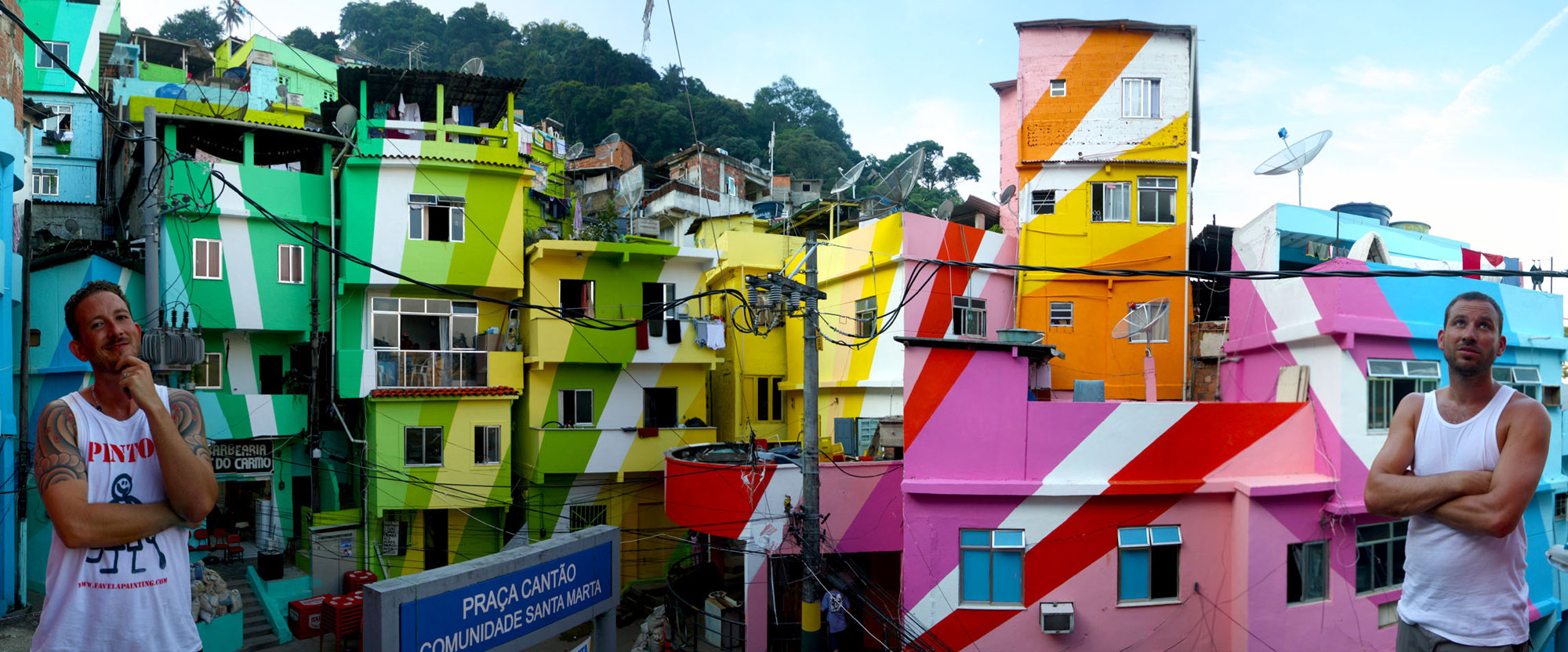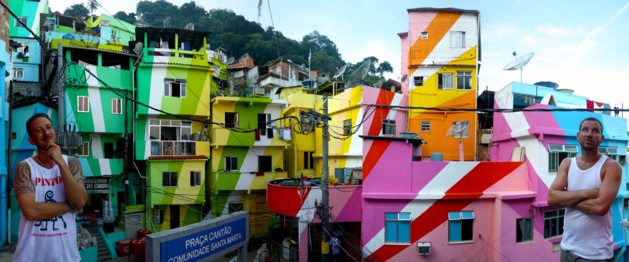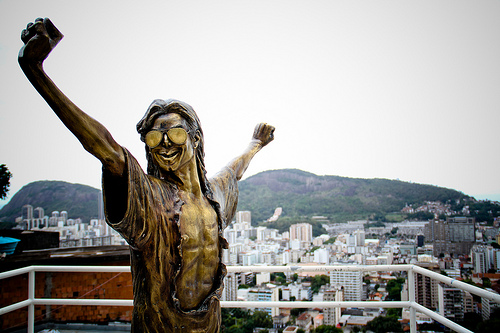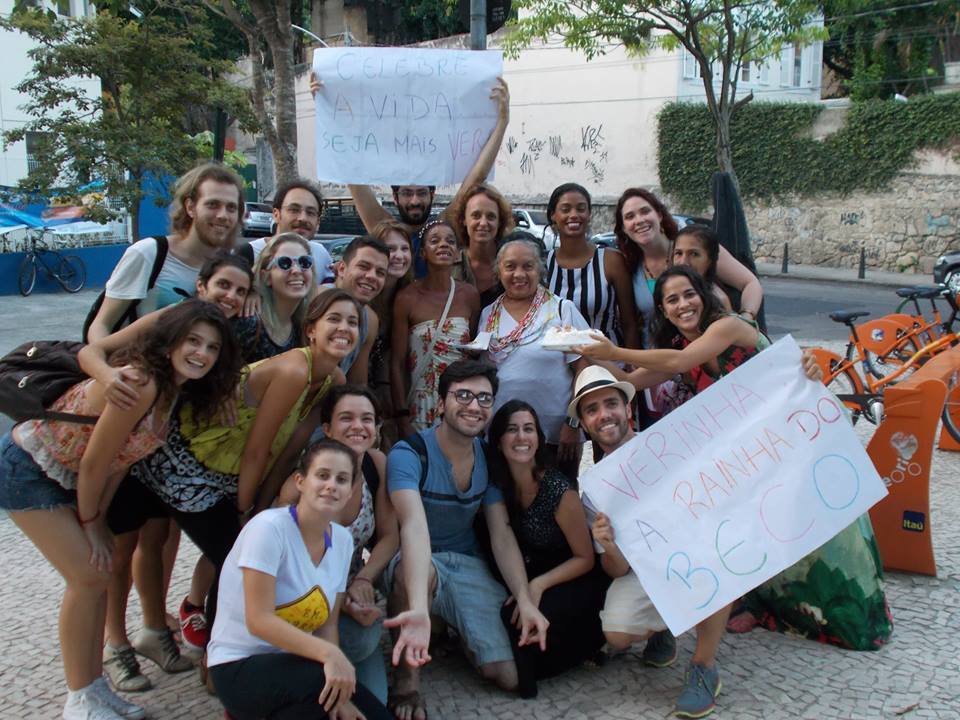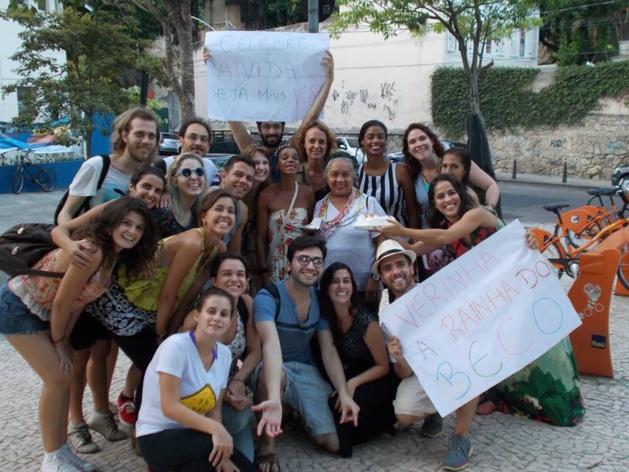As with every Thursday, the students meet at 3:00 p.m. for their performance course. However this time, the meeting point is at the bottom of Santa Marta, a pacified Rio favela situated in the city’s Zona Sul area. Throughout the semester, the course’s objective has been to discover the different aspects of performance through five modules. The first is about performative language, the second about the usage of autobiographical material to construct the performance, and the third, the interpersonal aesthetic in various spaces. The students are currently in this third phase. Here, “the performance is about the rapport, and it has to be developed”, Tania Alice explains, before adding, “my goal is that they begin to consider the performance in four dimensions: the autobiographical, the interpersonal, the social, and the spiritual”.
And so, the students embarked on the project of lending a helpful hand in the Santa Marta favela. “There is more open-mindedness in the favelas than in the middle class where people are scared. There is less fear here”, explained Julia, one of the students. Their goal is thus to create an interpersonal plan, by meeting the inhabitants of the community. This far from banal course allows for the transition to the fourth module, that is, the social art project, that doesn’t have any specific aesthetic but rather would allow for a taking of the reins and offering of services that the city’s organization does not. As Tania Alice indicates, it is also a way to “highlight the shortcomings of society”.
GIVING A BETTER IMAGE OF THE FAVELAS
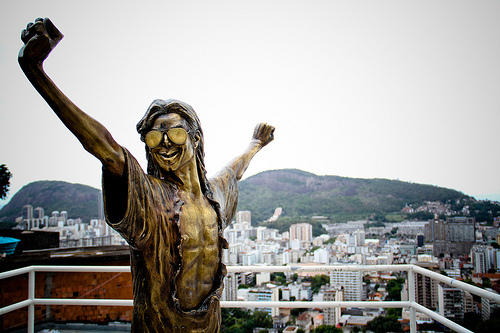
Crédit Pedro Serra
Whether alone or in groups, students or volunteers, all were to offer help to inhabitants of the morro (favela). Sharah brought her voice and her violin to sing with the citizens. She enjoyed the direct relationship with the people and she enjoyed offering what she most loves to do in a lively ambiance; it was short-lived but intense. Ana Paula, a volunteer inspired by the exercise wanted to give a better image of the community. According to her, we often emphasize the marginalized, negative, and excluding aspect of the community first. You never hear people of the favela speak about the favela. Her goal was to ask people what they wanted to showcase about where they live, to take a picture of it and send it back to them.
Guilherme’s idea was quite similar although it consisted more so of taking pictures of people in their day to day lives, without any particular poses and to send them the final product. In an age where no one develops film photography anymore, he wanted to give photography its value back. Fernanda and Alarisse were offering the preparation of fruit salad from A to Z, from the peeling, to the cutting, to the tasting. The two students offered a moment of togetherness. “It’s great to interact with people; to do what we love; to take the time to cook and talk”, said Fernanda. Roberta and Marcio went around the community recommending books to read, but not just any books. Inspired by the phenomenon of leaving a book somewhere for someone else to enjoy, Marcio thought about another form of “travelling books”. In four short poetry anthologies, the student stuck an explanation of the concept of “de mão em mão” (from hand to hand) as well as a small envelope where a message can be left for the next reader. Angela, Vitoria, and Samara had the idea of creating an event: throwing a small party for someone to celebrate something they are proud of. As such they wanted to ask the question: “what counts most in the society”?
A DIFFERENT REALITY
Through this course, Tania Alice wants to show the students the reality of the performer’s terrain: going out to meet people, introducing oneself, and creating an interpersonal performative action-plan. However, the objective is also to see that each experience is unique and that the different instantiations of the performances do not lead to the same result. In fact, the results would be different. Although some may have had success in establishing relationships, others may have had a little more difficulty; as is the case with Guilherme who was not able to take any photos, and no less communicate with the people. “They wouldn’t answer, it was so strange”, lamented the student, “we spoke with three or four inhabitants, but no one wanted their photo taken. ‘Go that way’, the people would tell us.” Disappointed, but not discouraged, the student thought that it was a good experience, even one worth repeating. The context was perhaps unfavorable given that police officials were on the lookout for someone hiding in the favela. Similarly, nor was Fernanda all that convinced of her performance. Blindfolded, she held a sign offering help to carry groceries or other things, if the people agreed to guide her by the hand. She explained that it didn’t work very well because “people were surprised, they were too apprehensive [to do it]”.
On the other hand, when they returned, the fruit salad girls were truly enthusiastic: “it was incredible! A part from one woman who was tired from her day, many played along”, Alarisse explained to Tania while showing her snapshots taken during the performance. The afternoon was of the most joyful, with everyone sharing their experience, the surprises, the encounters, the photos…
However, the last hurrah came when Samara arrived, running, proud to announce that she had found someone to celebrate. 56-year old Vera was proud to have lived in the favela since birth and to be the caretaker for all those in Santa Marta. After having taken a shower and put on her Sunday’s best, Vera arrived to the acclaim of the performers, cake and balloons waiting for her, at the foothill of the favela. Joy and emotion rang in the air, children came around to enjoy the cake while passersby stopped to take photos. The young performance artists’ beautiful human and professional experience thus allowed for a rethinking of the function of art in a social context.














